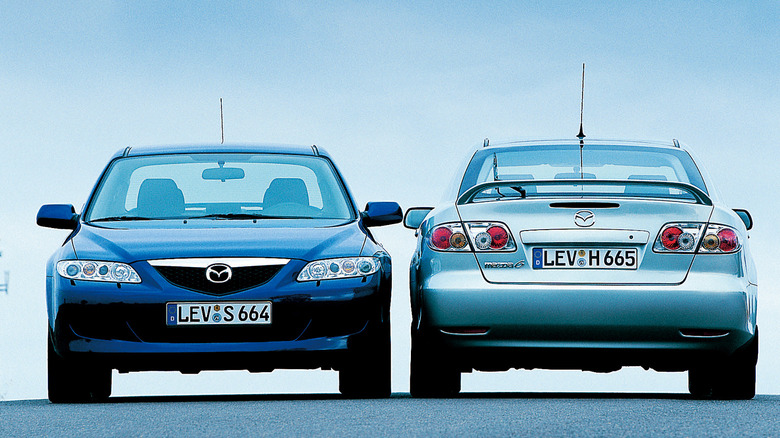No, The Mazda 626 Isn't Made Anymore - Here's Why (And What Replaced It)
Mazda has enjoyed a long and illustrious history of selling cars in the US, but unlike many American automakers, Mazda has restructured its model-naming policy a few times. Think of iconic American nameplates, such as the Mustang, Suburban, Thunderbird, or Charger — they all sport decades worth of different generations, and therefore the lineage is easily traced.
Here's where Mazda differs. Throughout the years, the Japanese automaker has taken new directions with its nameplates, which can mean keeping track of what replaced what can prove to be tricky. This can most easily be seen just after the 2000s kicked into gear, when Mazda dropped many then-familiar model names in favor of something a little snappier. For example, the Mazda 323 was discontinued and replaced by the Mazda3, a model that still survives to this day.
The Mazda 626 suffered a similar fate, having been discontinued in order to make way for a new model which too sported a model name more in tune with Mazda's then-new direction. To be specific, the 626's successor was the Mazda6, a sleek, midsize sedan that continued where the 626 left off. It first arrived as a 2003 model year in the US, securing more than 60 domestic and international awards within its first year of production. Despite huge amounts of success, Mazda dropped the model altogether in 2021, as it shifted towards a consumer-led SUV-heavy approach.
A closer look at the Mazda 626's life in America
The 626 has enjoyed a long life, having first been introduced as a 1979 model year. This iteration was short-lived, being replaced in 1982 with an all-new front-wheel drive model. This second-gen model impressed in the US, picking up accolades such as Motor Trend's "Import Car Of The Year" and featuring as one of Car and Driver's "10 Best" in 1984.
By the end of the '80s, the 626 was looking tired, and so a new iteration would debut just in time for the forthcoming decade. This latest model would look to further embed itself into American life, being assembled at the plant in Flat Rock, Michigan — the first US-based plant to be owned by a Japanese automaker. An all-new 626 would debut in the early '90s and be built alongside the stylish MX-6 and Ford Probe.
The 626's final guise would appear in 1997. By this point, the Ford and Mazda alliance was in full swing, as can be evidenced by the array of blue-oval engines that appeared under the 626's hood. It would be easy to brand the 626 a dull car, but that would be harsh. It had a job to do as a sensible, affordable, economical, and practical commuter, and it was perfectly tailored to the task. By 2002, the Mazda6 was poised to take the reins, and the 626 was therefore destined to live on in the history books. Although looking back, it's clear to see that it played an impossibly important role in establishing Mazda as a dependable Japanese brand in America.

